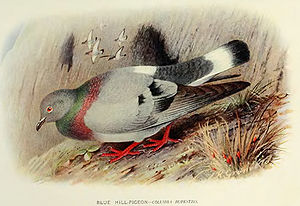Cliff pigeon
| Cliff pigeon | ||||||||||
|---|---|---|---|---|---|---|---|---|---|---|

Cliff pigeon |
||||||||||
| Systematics | ||||||||||
|
||||||||||
| Scientific name | ||||||||||
| Columba rupestris | ||||||||||
| Pallas , 1811 |
The cliff pigeon ( Columba rupestris ) is a species of pigeon birds. It occurs in two subspecies in East Asia.
Appearance
The cliff pigeon reaches a size of 35 centimeters. It weighs between 250 and 290 grams. Size and body shape correspond to that of a city pigeon. There is no gender dimorphism .
Cliff pigeons are very similar to the rock pigeons that are also widespread in Central Europe . They differ from this species by an additional white band that runs next to the white rump across the middle part of the tail feathers. The gray of the plumage is also a little lighter than that of the rock pigeon. Feet and legs are red. The eyes are orange-red.
Spread and behavior
The cliff pigeon is an East Asian species found in Mongolia, Tibet, northern China, Korea and Turkestan. In its way of life, it is also very similar to the rock dove. Like them, it is a rock breeder who, for example, builds its nests on narrow ledges. It broods in community. It does not seem to interbreed with city pigeons , although it nests near them in Ulaanbaatar, for example . The clutch comprises one or two eggs. The incubation period is 18 days. The young birds fledge after 32 days. After the breeding season, cliff pigeons live in large flocks. Sometimes these are also associated with snow pigeons.
Keeping in human care
Cliff pigeons were kept in Tierpark Berlin from 1962, where they were bred as early as 1963. The birds introduced were pigeons that were caught by the University of Halle in Mongolia. The Leverkusen zoo received two pairs in 1989, with which it was also possible to breed successfully. Even when accustomed, the cliff pigeons remained scared and shy. In keeping them, it was found that cliff pigeons prefer to eat very small seeds. Even seeds the size of a pea or a broad bean, which are eaten by other pigeon species, are not accepted by it.
literature
- David Gibbs, Eustace Barnes and John Cox: Pigeons and Doves - A Guide to the Pigeons and Doves of the World . Pica Press, Sussex 2001, ISBN 90-74345-26-3
- Alois Münst and Josef Wolters: Tauben - The types of wild pigeons , 2nd expanded and revised edition, Verlag Karin Wolters, Bottrop 1999, ISBN 3-9801504-9-6
- Gerhard Rösler: The wild pigeons of the earth - free living, keeping and breeding . M. & H. Schaper Verlag, Alfeld-Hannover 1996, ISBN 3-7944-0184-0
Individual evidence
Web links
- Columba rupestris inthe IUCN Red List of Threatened Species 2013.1. Listed by: BirdLife International, 2012. Retrieved October 30, 2013.